Q&A with Allan Duncan, course manager, Broomieknowe Golf Club
Related Articles
Duncan talks about his role as the course manager of a top Scottish golf venue.
Please can you give a description of your background?
I have been in the turf industry for over 26 years now. I began my apprenticeship at Drumoig GC in 1995 and remained there for 22 years and was part of the construction, grow in and maintenance team of the par 73 championship length course. While working there I was also part of the team to build what was the Scottish National Golf Centre based in the grounds of Drumoig.
This at the time, was a state-of-the-art complex with full driving range, three-hole golf course and extensive practice area with short game and bunker area around a massive 3000m2 arena green. Without doubt I learned so much working under course manager Ian Menzies, from the original design and build, we made many changes through the years, re-designing and improving almost every hole on the course. This most pleasing aspect of the redevelopments was that all work was carried out in-house and by staff working on the course. Work included full bunker redevelopment, pond extensions and the redesign of over half of the holes on the course. As well as golf course redevelopment, the owners also had an eye on sustainability. In my last few years at the club, they undertook a £300,000 green initiative. This involved the installation of ground source heating across the old 18th and the current ninth fairways to provide the complex with hot water and solar panels on the clubhouse and shed, creating our own electricity as well as a supply back into the grid.
Originally on a three-year block release in 1995-1998. I then became a late developer and carried out my SVQ level 3 in 2015 condensing it into a six month period distance learning. I then went straight into my HNC in golf course management, distancing learning again at SRUC Elmwood and was lucky enough to be selected as an R&A scholar during my studies and winning the Scottish student of the year in 2019 for my HNC work. I then took my first step into management and accepted my first head position at Thornton GC. It was a quick two years there before being lucky enough to be offered the course manager position at Broomieknowe GC in early 2021.
I have volunteered at a few events now and would say my experiences at the Solheim Cup venue Golf Club Sankt-Leon in Germany and Sentosa Golf club in Singapore were real highlights and where I learned the most about agronomy. It has given me a passion for sustainable greenkeeping and what can be achieved with a little hard work.
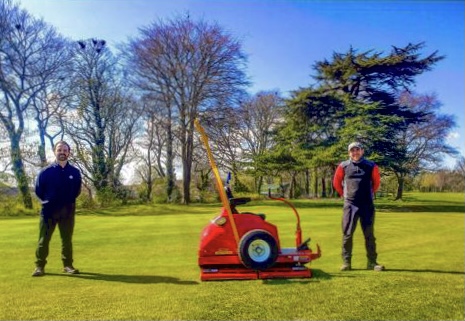
Social media has worked positively for you, the club, members and followers. How do you approach communication via the platforms and what have you found the benefits to you, the greenkeeping team and the club?
Most golf courses nowadays use social media regularly to update members and followers of their activities at their club. At Broomieknowe we have a very active social media presence and have a designated marketing and sponsorship sub-committee to maximise our potential and reach of the golfing community. I cover the greens and we have two others who carry out the clubhouse, competition, and sponsorship side of things. I believe strongly in using social media, club blogs / reports to educate, inform and show our members and followers what difficulties we face and what we are trying to do to correct and improve them. I feel that it is better for staff to show and explain what / why you are doing certain things than to simply show nothing. Members will make up their own minds on what / why we are doing certain tasks, which isn’t always positive. I think it is better to inform them using facts and data to back you up, rather than let them draw their own conclusions. It is also a great way to advertise your course, especially when the weather is playing ball! You just can’t beat they glowing stripes and close ups of your greens. It’s advertising and free!
What are the things that you enjoy most about your job, what accomplishment in your career are you currently most proud of and how does this make you feel?
There is not one particular task I love the most about my job, but I do take enormous pride and enjoyment from my work. I would like to think that in each place I have worked I have contributed to making a real difference in improving the course aesthetically and with its playability. I would say that at the age of 37 and with two young kids, the prospect of me going back to college was a little daunting, especially being away from education for so long. However, it is without doubt the best thing I have done for my career. Thanks to the R&A scholarship programme and Elmwood College, it has taken me across the world experiencing a little bit of warm season grasses as well as give me the knowledge required to take my first steps into management.
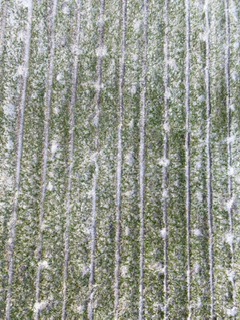
The club invested in a Tru Turf RE50 greens roller with lithium batteries, what most appealed to you about the electric option, what has surprised or impressed you most about this option and how often will you be using it as part of your programme?
Normally we would roll greens two to three times per week during the cutting season and twice a week during the winter. We as a club are trying to do our bit for the environment and in the due course be as sustainable as possible. The decision to go electric was an easy one for us and the staff. Normally the petrol versions are noisy and full throttle go, go, go. However, we were really surprised on demonstration how good the electric version was. Although we don’t have too many undulations on our greens, the RE50 lithium stood out with its ability to roll over 36 greens off of a single charge, ample power and traction along with delivering a smooth crease free putting surface; the seven-year warranty on the batteries will make it hassle free and an easy choice for us. The fact it’s whisper quiet is a bonus for staff during operation, but it’s also quite surreal hearing the birds chirp away having a conversion with colleagues while changing holes and rolling greens!
The club has invested in a new clubhouse which looks amazing. What major projects will you be undertaking across the course in the coming year?
The club has just recently completed a new £2.3 million clubhouse. The idea was to make a golf club that our members would thoroughly enjoy and want to come back to (golf course included). We have introduced a Trackman golf simulator room for anyone to use and various projects to keep interest high in the clubhouse side of things. The course is going to undertake a few changes also, with an ‘out with the old and in with the new’ idea too. A full bunker renovation project is planned to commence this winter with various new greens and tee complexes constructed too. The irrigation system will be overhauled and also receive an upgrade, showing that we have real ambition to improve the course as well as the clubhouse for our members.
The club has seen a growth in membership, which categories have grown in particular and how do you think this will help the club for the future.
Covid has been difficult for all of the clubs. The high end, large upmarket resorts have been hit the worst with foreign visitors unable to travel. Traditional, smaller members’ clubs that previously seemed to struggle have seen a surge in membership, so it’s been a real turnaround for golf. We have a main council of 10 members with three sub-committees consisting of approximately three members in each sub. The council goal was to try and entice a variety of new members to the club with an eye out especially in the junior section. We currently have around 750 members in total and are almost at full capacity and looking to introduce a waiting list shortly. We had a large rise in the full paying gents’ category, and significant increase in the young adult’s category. When you couple this up with having 100 lady members and over 100 junior members, the club is thriving and doing everything it can to secure the long-term future of the club.
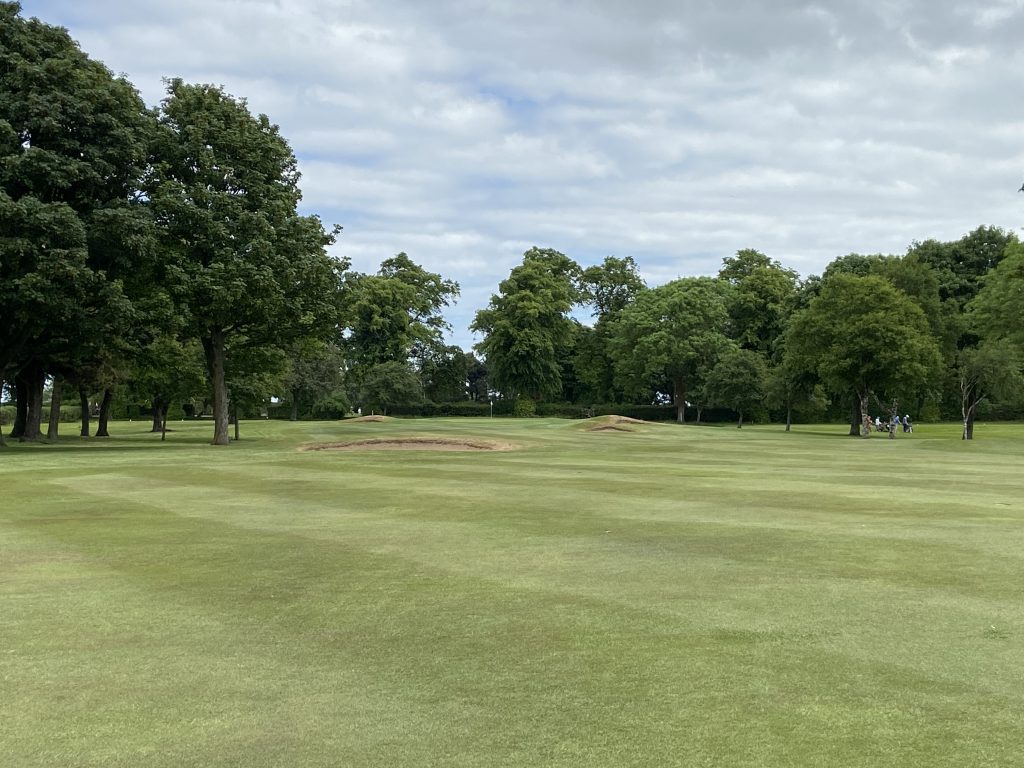
You are undertaking a seed exchange programme on the greens, what are you looking to introduce and what is the ultimate goal?
After a very hard winter up here in Edinburgh we suffered badly from frost and ice damage. There were roughly 13-14 greens damaged in some shape or form and a 60 percent loss of grass cover on three of our greens. We overseeded a number of times using ultra-fine ryegrass just so we would get a quick hit and some grass cover back on the bare areas once the soil temperatures had lifted. After initially starting I had some soil and nutrient testing carried out by Greentech Sportsturf who sent the samples to Ana-Lync.
When the results came back it appeared we had a real challenge on our hands. Organic matter numbers came back at 20-26 percent in the top 20mm indicating that we needed sand, sand and more sand! The poa dominant sward has its difficulties requiring more nutrient and water and then there is the susceptibility to disease because of the thick layer of thatch that is present. So, before I officially started, I was directing staff to carry out quite a severe approach to reduce the organic matter.
We hollow cored, solid tined and Graden sand injected all 19 greens before the beginning of April integrating approximately 80 tonnes of loose and kiln dried sand. We have set a target of around 230 tonnes per year to try and get in the region of six to seven percent organic matter as soon as possible, but I think it will take us roughly four years to achieve this. We aerate every month using a variety of methods, pencil tines and deep Verti-drain, and hollow core with ninja tines is carried out throughout the playing season, Verti-cutting and scarifying in between, and applying a light dressing each time we do this. The goal is to then begin overseeding twice a year with a suitable browntop bent that will reduce our nutrient and water inputs once it is established.
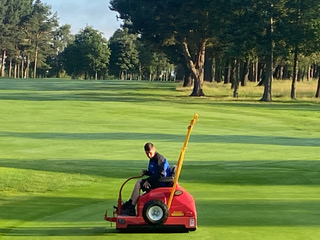
What machinery fleet are you currently using and what are your thoughts on electric powered mowers, what technical advantages do you think they might deliver?
We have invested heavily this year in an almost entirely new fleet. Previously the club would do a five-year lease deal with one supplier but we have gone down the purchase route this time round so we actually have something to show for our money at the end of the payments. We went for Toro equipment mostly, committing to buying the new 3370 electric greens mower, 3420 approach mower, 5610 fairway mower, Workman HDX, H800 Cut & Collect along with a designated Multipro sprayer. We also purchased an Iseki 6675, Wiedenmann XP8 and Maredo fairway scarifiers too, not forgetting our Tru-turf RE50 and Lastec rough mower. It has been difficult to say the least with Covid and Brexit restrictions but hopefully all of our machines ordered will arrive soon and we can really kick on with the golf course presentation.
As mentioned, we are equipped with solar panels on our clubhouse and produce our own electricity, so this is an avenue we have gone down by purchasing the electric Tru-turf and the Toro 3370 all electric greens mower. We have also started one by one replacing our hand-held petrol power tools to electric versions also. The noise reduction, cost efficiency in charging and using, along with the minimum maintenance and removal of hazardous oil leaks and fuel consumption are all massive positives for the environment and our staff. What is great is the environment is still being protected and helped without any loss of performance which is key in our presentation. It is without doubt moving forward and becoming an integral part of our industry.
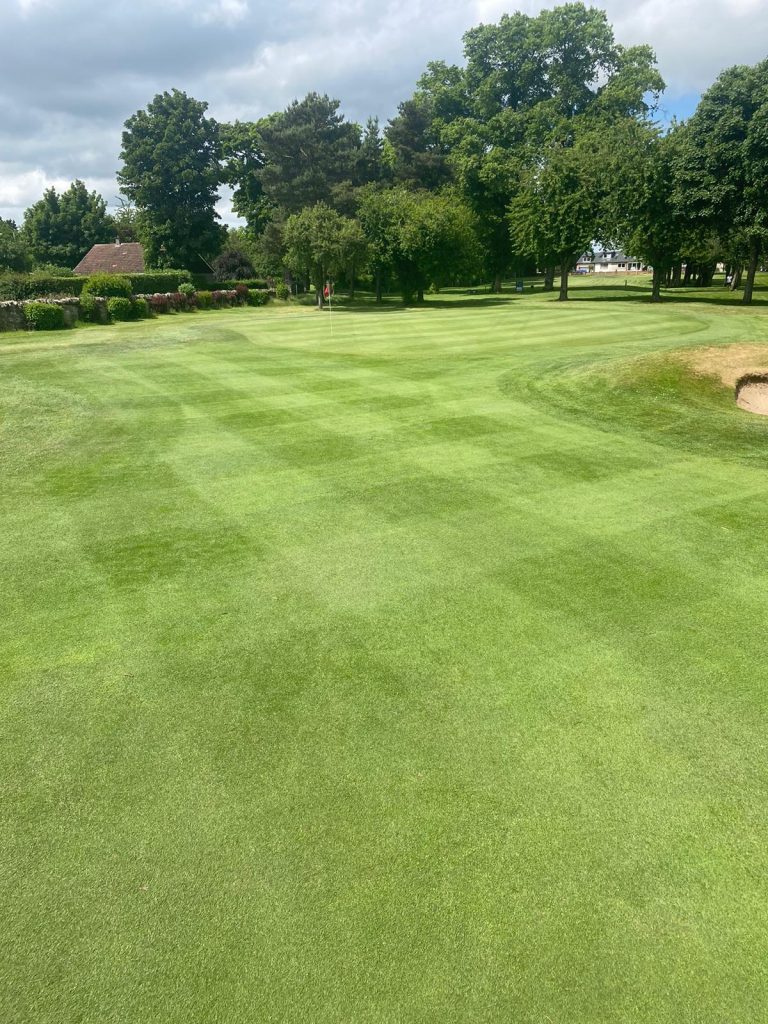
How reliant on technology are you and the team now becoming and what benefits do you see?
I think as an industry we are becoming more and more reliant on technology. The introduction of GPS to not only sprayers but most forms of mowers now is incredible and the accuracy that they deliver is as good if not better than actually having an operator on a machine. We also use platforms like TurfKeeper and moisture meters like the Pogo and all different kinds of apps on our phones to log and store data, helping us to predict what and when our next applications are going to be.
We collate data and use it in committee meetings as a tool to back up why we need to carry out certain tasks and pass it on to members in our blogs again to prove our work is all calculated and not just doing things on the course because it’s what we have always done. The use of bio-stimulants is becoming more and more popular with the withdrawal of certain chemicals looming every year. The industry in general is moving forward at a fast pace and ever evolving. I sometimes get the feeling that the industry is split into two. The breed of greenkeepers who react to certain challenges and the breed that are proactive and try to stop the challenge before it becomes an issue. Technology is the thing that drives this, even at 42 I feel the younger generation are better equipped and have so much more at their disposal in terms of maintenance and will continue to raise the bar moving forward.
What advice would you give to young green keepers starting on their career journey?
Probably don’t be shy. Ask questions all the time, keep a diary, build your own personal knowledge, and expand at any chance you get. Volunteer, attend seminars, apply for jobs to gain interview experience and be prepared that you are going to get told you were unsuccessful. Sometimes a step back is as good as a step forward if you are working for the right company or individual. It is all a learning curve that will eventually prepare you for the right position at the right time.

























